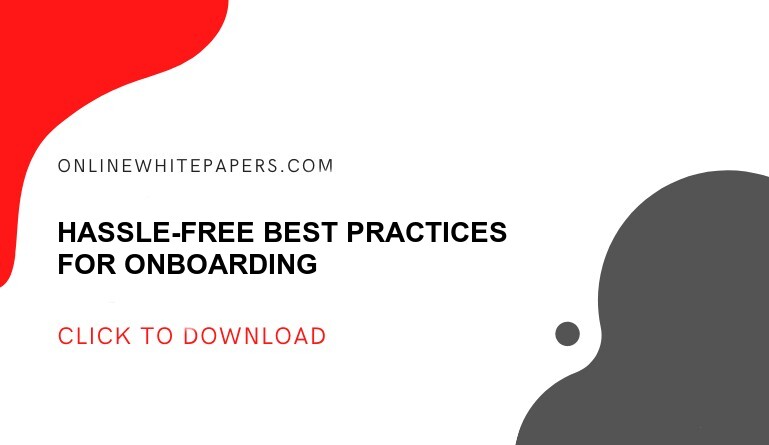What if the sugar in the coffee isn’t stirred in? It will sink to the bottom, leaving itself to wonder why it was even introduced to the frothed milk in the first place. Thus, stirring is an important step in combining the sweetening characteristics of sugar with coffee. Likewise, when a new employee starts working for a company, onboarding helps them connect their ambitions with the company’s goals. This entails building a solid bond to fuel an employee’s excitement for the job and desire to innovate while also assuring they feel included, accepted, and committed to the department’s and company’s goals.
According to the Human Capital Institute, onboarding that fosters engagement and human connection improves new-hire retention by 82 percent and increases productivity by 70 percent(1).
Onboarding is more than just a paper-push operation that deals with payroll, tax information, employee handbooks, and benefit papers. However, these are essential phases, and it expands to include introducing a new hire to the technical setup integrated into the system. This helps in aligning the new hire’s EQ and skills with the company’s strategic mission.
Onboarding is a welcome kit that new hires must receive when they start working for the company. Compliance, clarification, culture, connection, and check back are the actual contents of this kit.
( Also Read: A Step-by-Step Process for HR Onboarding )
The Reasons Why Employers Should Optimize Their Onboarding Programs.
-
Turnover Can Be Reduced Through Onboarding (and Turnover Costs)
According to a BambooHR poll of 1000 employed US workers(2), 31% of new hires leave their jobs within the first six months. Lack of training and unmet expectations are two of the critical causes of this troubling figure.
Employee turnover is not only a complex problem in terms of work distribution for companies looking for the right fit, but it is also costly. According to Gallup, turnover costs businesses in the United States $30.5 billion per year(3).
Therefore, employers should not delay including onboarding programs in the recruitment process and avail vital benefits, such as improved engagement, reduced time to competency, and lower attrition.
-
Methodizing Onboarding Is a Competitive Advantage
Companies devote a tremendous amount of time and resources to attracting excellent people. Given the fierce talent competition, it’s conceivably essential to ensure that the organization provides these ace performers with every opportunity to get a solid start on work and build connections. Otherwise, the organization would lose a good fit candidate, but their investment in the search and selection process would grow as well.
Because onboarding begins the moment someone accepts the company offer, it’s an excellent consideration to make them happy with their decision before they start. As a result, onboarding should be an educational, engaging, and enjoyable process for the new hire. Systematized onboarding procedures lead to 50% greater productivity(4) than non-standardized onboarding.
-
Ensure Workforce Compliance from Day One via Onboarding program
Compliance is the principal method of acquainting a new employee with the company’s policies and processes. It establishes the tone for an employee’s experience at work, including what kind of behavior is anticipated, how to deal with clients and co-workers, and so on.
Do not urge the new hire to immediately take to the floor without completing the compliance procedures of documentation, employee verification, and employment authorization. Finally, ensure that they understand their responsibilities and position as a team member in the organization.
Employee performance suffers when organizations neglect the compliance part of the onboarding process. With onboarding, the employer can build the best team.
-
Onboarding equips new employees with the information they need to get started.
The next significant part of onboarding is information propagation. It is directly tied to how successful new hires will be in their roles. It covers everything from providing employees with the tools and resources they need to gear up for work and enables a long-term relationship with management and leadership.
The onboarding process in this phase allows the employers to explain key expectations, clarify ambiguities, and respond to critical issues of newbies before they become productivity crushers.
-
Onboarding contributes to the maintenance enrichment of organizational culture
The company’s culture is built on organizational conventions, fundamental beliefs, and goals. Essentially, culture is an organization’s personality and character.
A newcomer’s initial interaction with organizational culture occurs when they browse the company’s website. By highlighting its mission, vision, and values, the website provides an insight into its culture. Culture, however, does not simply describe a company’s attitude; it also explains how employees interact, cooperate and generate output at the workplace. As a result, the onboarding process is the environment in which business culture is cultivated and nurtured.
HR leaders must devise a method for assisting new hires in settling in. According to BambooHR report 76 % of new employees advocate On-the-Job Training(4). Incorporating regular training for current employees and onboarding new employees into the culture is a crucial method to keep your company’s values front and center.
-
Onboarding cultivates collaboration, mentoring, and leadership skills
Not only can welcoming new hire reduce their stress, but it can also contribute to increased productivity. Everyone else knows everyone, and therefore the sooner HR managers assist newbies in acclimating, the sooner they will feel at ease and begin producing their finest work.
An experienced employee meeting the new hire and normalizing the work atmosphere by showing them the “ropes” and other essential aspects helps remove awkwardness in the first day in a new environment.
Mentorship in the onboarding program provides new team members with resources to lead, reassure, and reorient them while also becoming a part of the team culture and vision.
On the other hand, leadership opens the door to empathy and understanding of the new employee’s skill set and how to develop those skills effectively.
HR Managers use these phases to develop members of their teams, pass on institutional knowledge, and contribute to the creation of future organizational leaders. Employees will be inspired to pursue responsibilities within the company rather than looking for other jobs.
-
Onboarding holds the Managers Accountable
A terrible manager can destroy a good team, prompting the best employees to leave and the remaining employees to lose all motivation.
Periodic meetings with managers and employees, or skip-level meetings, especially at the start, are the best methods to regulate attrition and discontent. These check-ins serve as indicators for employee happiness, but they also help create affinity, provide employees the opportunity to share feedback, and hold management accountable. The advantages of such meetings are self-evident as it offers unfiltered access to information about what’s truly going on in the company for the better or the worst.
Organizing such meetings could save the employer from losing a rich talent and evade hiring.
-
Implement an Effective Onboarding Program with ease
5C’s principle makes the onboarding process as easy as pie. Give recruits early access to knowledge and use technology whenever possible, according to the 5 C’s — compliance, clarification, culture, connection, and check back. Each C is an essential procedure, phase, and core skill in the onboarding process.
- Compliance: It is a foundational understanding of your company’s policies and procedures.
- Clarification: Concentrate on defining the new associate’s job and accomplishments.
- Culture: New employees are exposed to the company’s culture through its website, during their interview and when they start working
- Connection: Managers should encourage each new employee to develop interpersonal relationships within your organization’s interactions and information networks
- Check-Back: Set up check-in meetings with each new hire 30 days, 60 days, and 90 days in advance.
Final Thought
An automation tool such as Compli or Apty simplifies the process and enhances the onboarding experience. Compli is a cloud-based HR and compliance management solution for the entire staff. It automates learning and compliance business procedures for employees and managers in a straightforward solution. Aptly provides a package that includes high-Impact, seamless remote employee Onboarding and Training tools.
During this critical period, an effective onboarding program can give new workers a window into business culture and shape their perspective of their future workplace. A positive first impression encourages employees to stay, whereas a negative first impression might exacerbate turnover issues. Onboarding programs are beneficial as new hires take less time to engross themselves in a particular organizational ecosystem.








